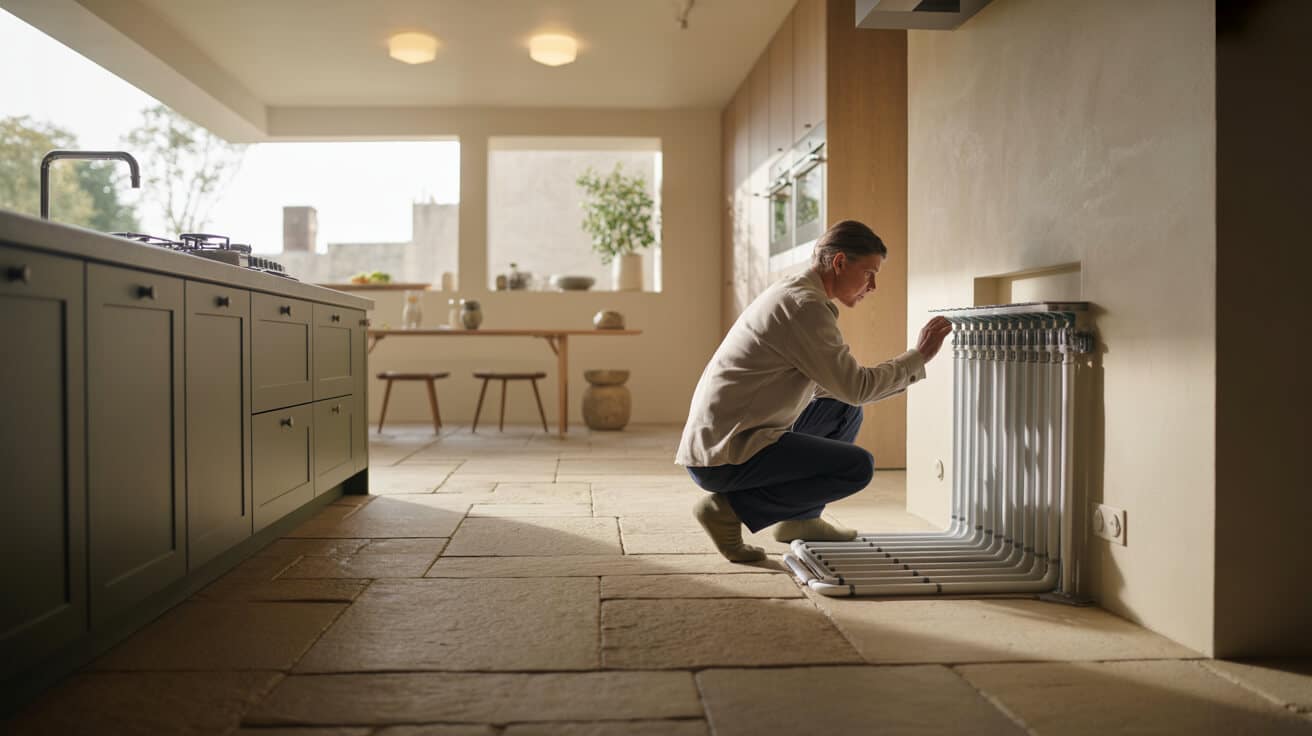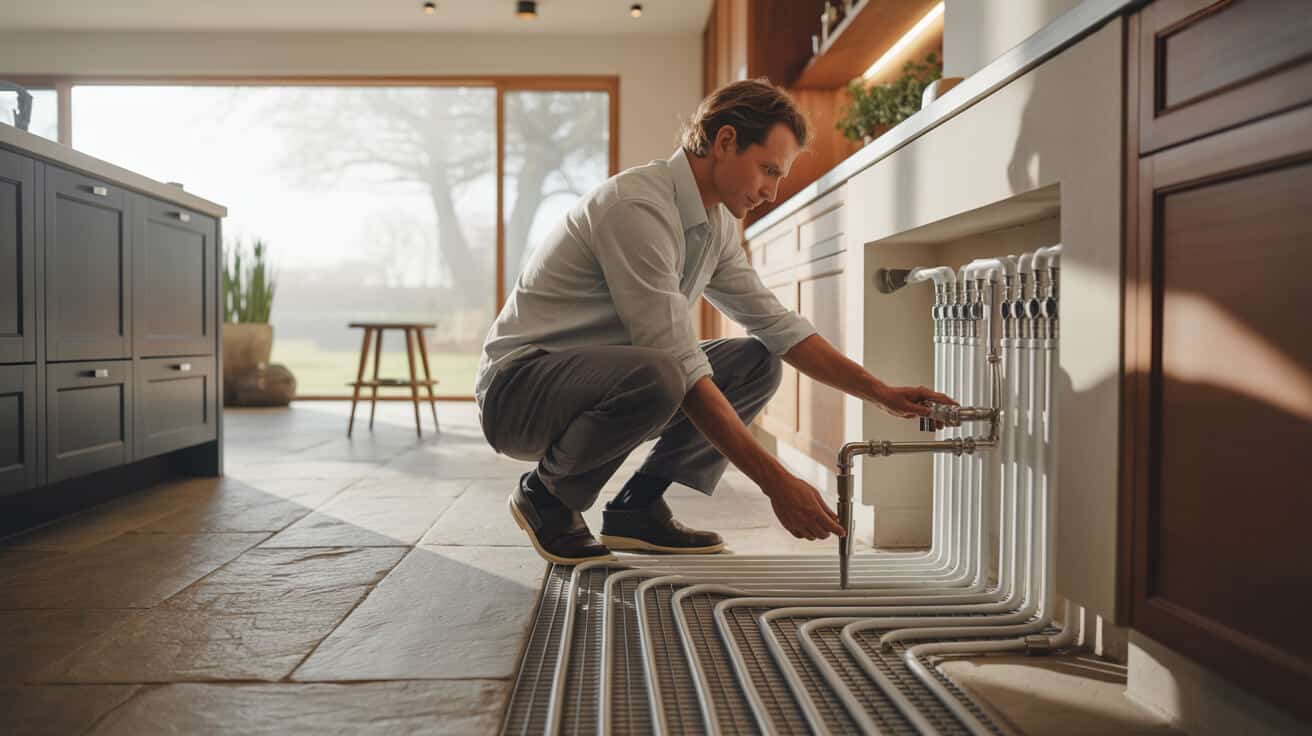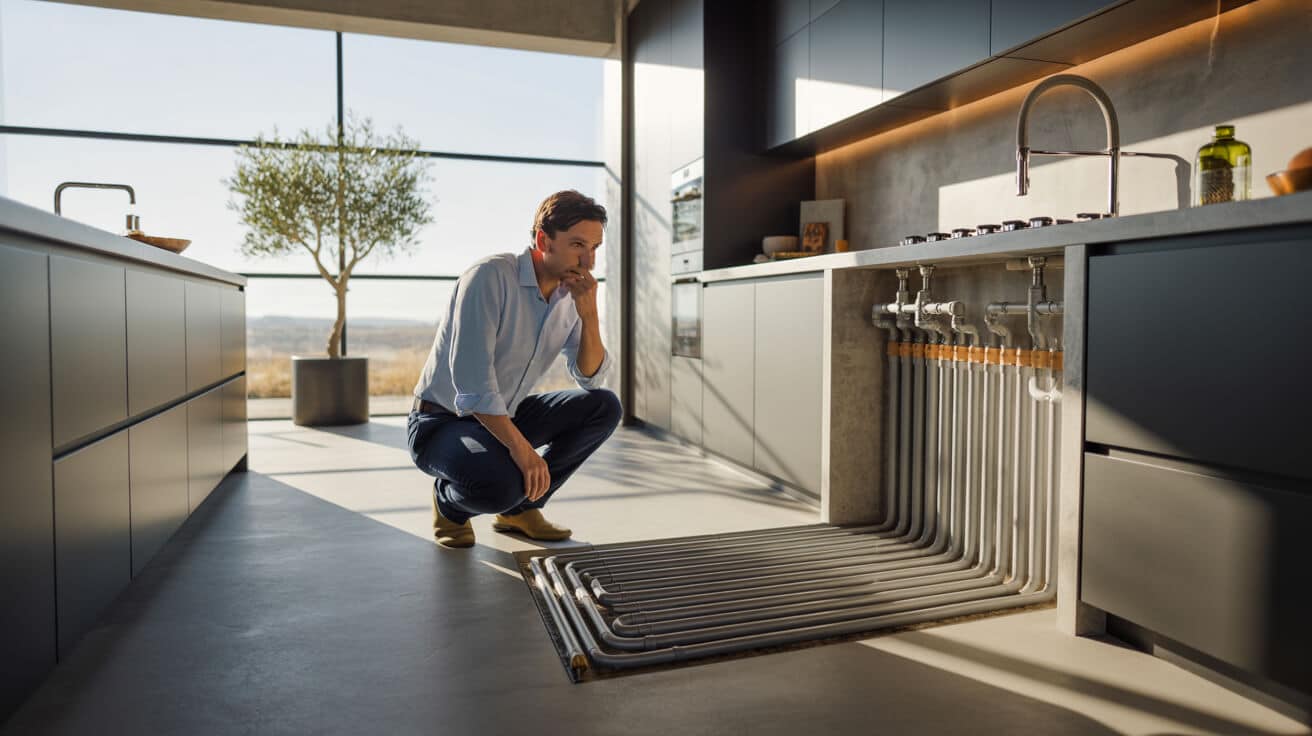Polypipe’s radiant floor systems function by harnessing the thermal capacity of building floor structures, creating a platform for uniform, responsive heating. By embedding water-filled pipes or heating cables beneath finished floor layers, these systems support both comfort and environmental objectives—their ability to operate at lower fluid temperatures often translates to enhanced energy performance. The modular architecture and flexible installation options facilitate deployment in new construction, refurbishment, and retrofit settings. These features, coupled with compliance to UK Building Regulations and recognised industry certifications, have made Polypipe underfloor heating a reference standard for property improvement and facilities management professionals. In markets where installer expertise and guaranteed outcomes are vital, certified providers such as Plumbers 4U play a central role in designing, installing, and maintaining these systems to exacting standards.
Etymology or name origin
The designation “underfloor heating” denotes a class of technologies in which the heating element is distributed beneath a chosen floor surface, typically as a way to produce consistent vertical heat gradients in occupied spaces. This term was formalised as an engineering descriptor in British standards to distinguish radiant-based systems from those reliant upon above-floor or wall-mounted emitters. “Polypipe” itself originated as a compound neologism reflecting the manufacturer’s historic association with extruded polymer piping solutions—a lineage that spans water supply, drainage, and systemized heating components within the United Kingdom’s construction supply chains.
Overview and context
Underfloor heating is recognised as a strategic response to evolving requirements in energy management, interior design, and occupant wellbeing. The approach distinguishes itself from traditional radiative or forced-air systems by relying on low-temperature output and floor-to-ceiling heat dispersal, minimising cold spots and promoting even thermal comfort. Within the context of the UK plumbing and heating sector, Polypipe’s contributions have enabled widespread adoption of radiant floor systems across a spectrum of asset classes—from one-bedroom flats to educational, medical, and leisure facilities. The rising prominence of these systems is closely tied to shifts in building energy codes, which reward low-carbon heating, and to market pressures emphasising unobtrusive, space-saving design. The growing prevalence of multi-zone programmable controls further positions underfloor heating as a bridge between traditional construction methods and digital building operations.
History
Ancient origins
Radiant underfloor heating has roots extending to the classical world: Roman hypocausts and Korean ondol systems circulated heated air or smoke through subfloor cavities to achieve even room warming. Mediaeval and early modern innovations in flue-based floor structures informed many technical precedents.
Industrial emergence
The 19th-century industrial revolution provided the material sciences framework for piping, insulation, and safer, more reliable heating elements. By the mid-20th century, British and continental engineers began introducing electrically powered mats and initial hydronic pipe networks, but mass deployment was limited by material costs and control technology.
Contemporary evolution
Advances in plastics engineering, particularly the development of cross-linked polyethylene (PEX) and polybutylene (PB) pipes in the 1970s and 1980s, enabled scalable, flexible, and long-lived pipework capable of extended service in embedded floor environments. Polypipe’s entry into radiant heating synchronised with these technological advances, launching integrated system packages for UK building markets. Over subsequent decades, the company continued to innovate not only in piping but also in low-profile overlay boards, castellation mats, smart zoning controls, and renewable system compatibility, in parallel with growing regulatory expectations for energy performance and compliance documentation.
Brand milestones
Polypipe’s role in systematising the installation process—via coordinated distribution manifolds, clip-rail and board supports, and programmable thermostats—has positioned it as a preferred British brand for floor heating. Serial product line expansions, including screeded, overlay, and floating floor solutions, have ensured widespread applicability across new build, refurbishment, and extension projects, consistent with the evolving needs of the UK construction sector.

Description and construction
Hydronic systems
Water-based, or hydronic, underfloor heating is the primary technology offered by Polypipe. These systems use networks of flexible PB or PEX pipes, generally laid in spiral or serpentine patterns. Each loop connects to a manifold, which mediates flow, temperature balance, and zoning. Insulation panels below the piping direct heat upward, while a screed or overlay board locks the system into the building’s thermal mass.
Electric systems
Where hydronic circuits are impractical, electric underfloor heating employs mat- or cable-based systems, placed atop subfloors, frequently under tiled or stone finishes. These systems offer ease of installation for small or isolated zones, at the cost of typically higher running energy requirements.
Core physical components
- Pipes: Flexible, oxygen-barrier PB or PEX, available in standard diameters (commonly 12, 16, or 20 mm) to meet precise loop pressure and flow criteria.
- Manifolds: Sturdy, multi-port distribution systems, incorporating isolation valves, flow gauges, and mixing/blending valves to facilitate accurate control and ease of maintenance.
- Insulation: Expanded polystyrene (EPS), polyurethane, or mineral wool boards prevent heat loss downwards, ensuring system efficiency.
- Overlay systems: High-density grooved boards facilitate rapid, low-impact installation over existing floors, increasing retrofit feasibility.
- Control and zoning hardware: Wired and wireless digital thermostats, programmable zone controllers, and integration-ready receivers enable tailored comfort across multiple spaces.
- Screeds: Cementitious layers, often 30–60 mm, anchor pipework in new builds for thermal inertia and stable heat output.
- Safety mechanisms: Each system is equipped with pressure relief valves, anti-scald limits, and temperature sensors to comply with safety norms.
Product subtypes
Overlay boards and panels
Prefabricated, grooved panels for pipe installation atop structural floors, minimising floor height buildup. These systems suit renovation and extension projects with limited floor depth.
Screeded and in-slab systems
Traditional embedding of pipes within a wet sand/cement screed, commonly used in new build constructions and large open areas.
Floating and modular systems
Solutions using castellated trays or pipe clips for fast, dry installation atop insulated subfloors, prevalent in timber frame and lightweight constructions.
Electric mats and cables
Quick-instal kits for bathrooms, kitchens, and areas with isolated heating demand, compatible with major flooring types and up to current regulatory codes.
Commercial and bespoke modules
Large-area and multi-circuit systems designed for offices, health, or education sector deployment, often specified with advanced BMS compatibility.
Controls and smart zoning
Zoned room-by-room or area-by-area management is enabled by independently programmable thermostats and wiring centres. These devices can operate stand-alone or in networked ‘whole house’ configurations, with options for remote programming.
Principles of operation
Radiant heat transfer
Rather than relying on convective air currents, underfloor heating uses surfaces as primary emitters, producing a gentle, consistent warmth rising from the floor. This approach creates a more stable vertical heat gradient and can enable lower air temperatures for equivalent comfort.
Hydronic flow path
Low-temperature water, typically 35–55°C in modern systems, circulates through parallel or zoned pipework loops. Flow rates and pressure drops are balanced at the manifold, usually located in a convenient service cupboard. Return water is reheated or passed back to the heat source, maximising extraction efficiency from boilers or heat pumps.
Thermostatic and timed control
Sensors embedded in floor surfaces or wall thermostats allow granular, programmable temperature control. Schedules, occupancy sensors, and weather forecast compensation can be incorporated for higher performance or efficiency. Systems licenced to Polypipe standards are compatible with a range of digital and traditional control protocols.
Applications
Residential buildings
Embedded heating is prominent in detached and semi-detached houses, apartments, and high-end renovations. The system’s ability to operate invisibly supports open-plan layouts and maximises furniture arrangements. multi-zone controls adapt comfort to distinct usage patterns and individual room needs.
Retrofit and extensions
Polypipe has invested in overlay and low-profile variants well-suited to updating older buildings. These systems help maintain clearance to doors, thresholds, and heritage floor finishes, addressing owner concerns about disruption or loss of character.
Commercial and public spaces
Schools, offices, clinics, and public amenities leverage the zoning potential and load distribution properties of underfloor heating. Floor build-up, insulation continuity, load calculations, and accessibility standards are critically assessed at design. The engineered predictability of Polypipe modules allows planners to meet evolving design and regulatory mandates.
Room-specific scenarios
Solutions are specialised for high-humidity zones—such as bathrooms and kitchens—and for large, open-plan zones where rapid, even heat distribution is desired. Flexible pipe layouts, spacing, and control methods enable designers to tailor outputs for specific use cases.
Hybrid system integration
Floor heating is now commonly paired with traditional radiators, towel rails, or wall-panel systems. Controls modulate flows to coordinate delivery in mixed environments. Compatibility with renewable sources such as air source heat pumps (ASHP), ground source heat pumps (GSHP), or solar preheating increases the carbon reduction potential for your building.
System types and product variants
Overlay systems
Overlay board systems address retrofitting by permitting pipes to be installed above existing subfloors, reducing floor height build-up. These modular products accept a range of floor finishes and allow phased area upgrades.
Clip rail and pipe-in-screed systems
Typical for new build or large floor areas, pipework is secured to insulation boards or rails, then set within wet screed. Support for longer loop lengths and larger zones characterises these systems.
Floating and castellated panel systems
Dry-instal methods using grooved boards or castellated trays function well in timber, modular, or suspended floor scenarios, speeding up deployment and minimising wet trades.
Electric variants
Mat and cable kits offer targeted, quick installation, ideal for bathroom or kitchen upgrades within more complex heating mixes. These solutions are routinely specified where hydronic systems are impossible or cost-ineffective.
Commercial and bespoke modules
For schools, clinics, and larger venues, Polypipe offers scalable solutions with design guardianship: custom manifold arrangements, multi-circuit balancing, and advanced zoning align performance with regulatory demands and specialised layouts.

Components and technical features
Pipes
Polybutylene and cross-linked polyethylene deliver a combination of resistance to corrosion, scaling, and fatigue. Manufactured to meet BS EN 7291 and BS EN 1264, these pipes are pressure-rated and installed using certified crimp or push-fit jointing.
Manifold and balancing
Stainless and composite manifolds distribute flow and are often equipped with circuit-specific flow metres, actuator heads, and isolation devices to enable precise thermal zoning and simple off-season servicing.
Insulation and panels
EPS, PIR, and mineral fibre boards are used for subfloor insulation, often with tongue-and-groove profiles or integrated reflective foil layers, to maximise upward heat delivery and meet U-value targets.
Pumps, valves, and safety features
Variable speed pumps and thermostatic mixing valves ensure consistent return temperature, safe user operation, and system longevity; pressure relief, air vents, and filling/draining devices ensure ongoing maintainability.
Thermostats and zone control
Digital, wireless, or smartphone-enabled thermostats, single- or multi-room, are now common. These enable programmable schedules, temperature setbacks for unoccupied spaces, and remote diagnostics.
Installation methods
Survey and design
Installation begins with a technical assessment: plans are overlaid with pipe/cable layouts based on thermal loss calculations, occupancy expectations, and room geometry.
Preparation and subfloor assessment
Floors must be levelled and inspected for damp. Insulation and vapour barriers are positioned to comply with current building and manufacturer standards.
Pipe or cable layout
Installers arrange pipework or cables per a grid: typical spacing is 100–200 mm, modified per heating load and structural span. Loops are anchored via rails, staples, or castellated supports.
Testing, balancing, and commissioning
Pre-cover pressure tests check for leaks or blockages; systems are purged of air and each loop is balanced at the manifold to ensure uniform delivery. Documentation is generated for compliance, warranty, and customer records.
Retrofit complexities
Overlay and floating systems minimise disruption, reduce labour and drying time, and enable zone-by-zone upgrades for minimal interruption.
Certification and training for installers
Accreditation from manufacturers and ongoing CPD are required for warranty support and compliance handoff. Installers are trained in layout, system sizing, balancing, pressure testing, and control system setup.
Performance, efficiency, and benefits
Thermal distribution
Uniform floor heating ensures no cold spots. The gentle upward radiation reduces air movement and stratification, supporting both comfort and energy savings.
Energy efficiency
Lower operational fluid temperatures (often 30–45°C for heat pumps) reduce losses and increase condensing boiler performance, directly influencing EPC scores and lowering running costs for your building or property.
Environmental factors
When connected to renewables or grid-decarbonized supplies, underfloor systems enable property managers and owners to meet or exceed carbon reduction goals, supporting grant eligibility and long-term legislation compliance.
Health and comfort
Reduced convection minimises airborne dust and allergen movement. Slightly elevated floor temperature is associated with greater occupant comfort, especially in bathrooms and areas subject to high humidity.
Space utilisation
The elimination of radiators frees wall and floor space, improving room aesthetics and supporting greater flexibility in furnishing and interior planning.
| Attribute | Underfloor Heating | Radiator System |
|---|---|---|
| Operating temperature | 35–55°C | 60–80°C |
| Spatial footprint | Concealed | Wall-mounted |
| Air movement | Minimal | Moderate |
| Zoning capability | High | Moderate |
| energy efficiency | Higher at low water temps | Lower at high water temps |
Maintenance and servicing
Routine maintenance
Annual inspection is recommended to verify pressure stability, control operation, and component integrity. Where necessary, the system may be flushed to remove sediment or deposits.
Troubleshooting and repairs
Typical issues include airlocks, cold zones, or low pressure, all identified and resolved using the system’s built-in access points and diagnostic protocols. Modern controls enable remote assessment of operational status, and proprietary support is supplied through certified providers.
Support and warranty
Comprehensive warranties are conditioned on certified installation and compliance with manufacturer’s maintenance intervals. Maintenance records are encouraged for future property transfer, tenancy, or insurance requirements.
Regulatory and industry context
UK and EU regulations
All systems must comply with the relevant sections of the UK Building Regulations, with particular emphasis on Part L (energy), G (sanitation), and M (access). BS EN 1264 certifies system performance and design, while WRAS, BBA, and CE marks identify product testing and certification. Ongoing updates to standards are routine, with the aim of driving energy performance upward.
Commissioning and documentation
Successful systems are accompanied by commissioning records, pressure certificates, zone diagrams, and instruction manuals, supporting building control sign-off, property sale, or new tenancy.
Accreditations and training
Approved installer schemes and ongoing professional development support safe, compliant, and high-quality system deployment. Training is provided via manufacturer (such as Polypipe) and recognised trade bodies.
Challenges, barriers, and limitations
Technical issues
Longer warm-up times in thick screeds, potential for design errors (excessive loop length, insulation gaps), and the need for system balancing and control programming are considerations for owners and engineers.
Economic barriers
Installation is typically more expensive upfront compared to radiator-based systems, although whole-life costs, reduced maintenance, and energy savings are documented advantages for your company or property.
Suitability and use case boundaries
Not all floor constructions are suitable for all system types; for heritage assets, or where build-up height must be minimised, specialist overlays or floating systems are preferred.
Maintenance obstacles
Access to embedded pipes or cables for repairs is more involved than with above-floor emitters; good documentation and proactive maintenance are key for ongoing reliability.
Stakeholders and industry participants
Manufacturers
Polypipe produces complete system packages and technical support materials, guiding both supply and installer networks. Similar companies operate across the UK and European heating markets.
Installers and engineers
Certified installers—such as those employed by Plumbers 4U—ensure compliance, system longevity, and support pathways for your home, estate, or facility. Trade competence and technical documentation are inseparable from system success.
Specifiers and architects
Design professionals optimise heating layouts, system sizing, and control integration to match your organisation’s priorities, minimising risk of design errors or compliance hassles.
Policy-makers and trade bodies
Regulatory and industry standards bodies define minimum standards, review product performance, and align certification/labelling schemes with public policy.
Property managers, landlords, and owners
Duty of care for compliance, safety, servicing, and documentation rests ultimately with your organisation or asset management team.
Impact, influence, and market role
Polypipe underfloor heating systems have directly supported national energy policy objectives, design trends, and the rising value proposition of floor-based radiant systems in both residential and commercial property. The systems’ contribution encompasses reduced on-site space needs, improved EPC scores, and enhancements in interior quality for you and your tenants. Market share growth is propelled by professional networks, documented performance, and recognition in commercial and institutional procurement.
Future directions, cultural relevance, and design discourse
Emerging trajectories for underfloor heating include predictive digital controls, advanced zoning through behavioural analytics, and further modularization for easier retrofit and adaptability. Materials science is driving enhanced recyclability, carbon-neutral production, and circular economy compatibility, aligning with government and sector-level climate commitments. Increasing regulatory focus on inclusive environments is reflected in systems that support accessible living, extending independence for an ageing population. Cultural references to underfloor heating as a marker of modernity, comfort, and architectural cleanliness shape both professional debate and the lived experience of property owners and managers.

